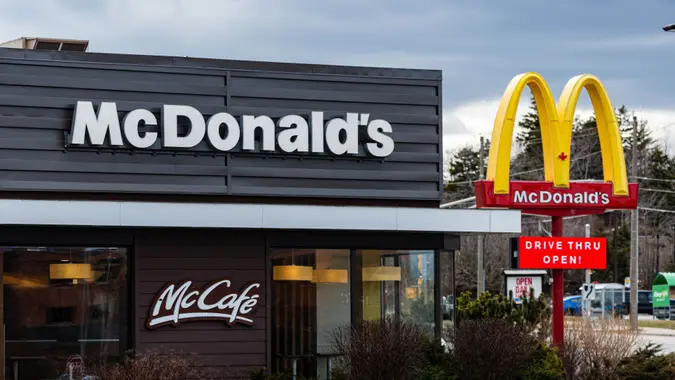Can Elon Musk Really Cut $2 Trillion in Government Spending? Here’s What It Would Take

Commitment to Our Readers
GOBankingRates' editorial team is committed to bringing you unbiased reviews and information. We use data-driven methodologies to evaluate financial products and services - our reviews and ratings are not influenced by advertisers. You can read more about our editorial guidelines and our products and services review methodology.

20 Years
Helping You Live Richer

Reviewed
by Experts

Trusted by
Millions of Readers
Anyone who has been following the news lately has heard a lot about Elon Musk. The Tesla CEO, billionaire entrepreneur, and social media mogul has emerged as a consequential voice among the forthcoming Trump White House. One of his boldest objectives? Improving government efficiency and “cutting the fat” of perceived waste and unnecessary regulations, along with trimming the federal workforce.
Musk and fellow Trump campaign surrogate Vivek Ramaswamy have been tapped to lead an advisory board informally dubbed the Department of Government Efficiency (DOGE) to tackle these issues — and yes, the acronym is definitely referencing the Dogecoin mascot. While DOGE isn’t an official government department, its leaders have ambitious goals to slash government spending by an eye-popping $2 trillion.
That staggering figure begs a basic question: Is it really possible for Musk and co. to enact such massive cuts? Unsurprisingly, the answer is complicated.
The Math Doesn’t Add Up
When CNBC reported on an initial meeting between Musk, Ramaswamy and members of Congress, reporter Emily Wilkins described a sense of receptivity to some of the DOGE team’s ideas among GOP lawmakers. However, there was tension in the room: “An unspoken understanding that Musk’s stated goal of slashing federal spending by $2 trillion is already DOA.”
Why? As the saying goes, “the math ain’t mathin’.” Based on the 2023 budget of $6.1 trillion, approximately $3.8 trillion is already committed to legally mandated programs like Social Security, Medicare, and veterans benefits. Add another $650 billion to cover the interest on the national debt, and you’re left with about $1.7 trillion for discretionary spending.
At first glance, $1.7 trillion might seem like plenty to work with. But once you account for major expenditures, like $805 billion for national defense, much of the remaining budget supports highly visible departments like FEMA, NASA, and Customs and Border Protection.
Simply put, the current budget math doesn’t support $2 trillion in cuts. Slashing national expenditures to such extremes would require a total restructuring of federal priorities.
Navigating the “Third Rail” of Politics
Certain areas of the federal budget are widely regarded as political “third rails” — topics so sensitive that politicians tampering with them would risk quite the electric shock from angry voters. Among these “third rail” topics are Social Security, Medicare, veterans benefits, as well as national defense — meaning it’s extremely unlikely that Congress would support DOGE taking a bite out of them.
Talk of privatizing Social Security contributed heavily to Republicans’ losses in the 2006 midterms elections, and outright cuts to these programs would likely become a political liability in the 2026 midterms.
Moreover, with a massive deportation scheme central to Trump’s platform, Musk might face strong resistance to reducing funding for Customs and Border Protection. Similarly, recent hurricanes have made FEMA’s disaster relief efforts highly visible — and politically untouchable — for the time being.
In other words, Musk and Ramaswamy would have to find ways to cut spending that wouldn’t incur the wrath of American voters or provoke Congress.
There Are Some Ways To Make Cuts
With the GOP’s slim House majority up for grabs in two years, Musk and Ramaswamy may need to abandon their go-big-or-go-home approach in favor of smaller, incremental changes.
While slashing billions from Social Security is politically toxic, mandating a return to office for federal employees could reduce inefficiencies associated with underused government buildings. Legislators like Senator Susan Collins of Maine and Senator John Cornyn of Texas have voiced support for such measures.
The assumption is that many workers would simply take their chances on the private job market rather than return to the office, potentially saving millions in salaries and benefits.
Focusing on smaller, more politically palatable reforms — rather than sweeping, controversial cuts — may be the best use of DOGE’s brainpower.
More From GOBankingRates
 Written by
Written by  Edited by
Edited by 

























